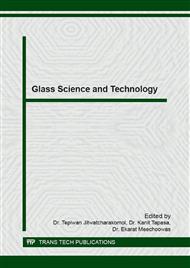p.96
p.103
p.108
p.113
p.121
p.125
p.130
p.135
p.139
Redox Effects of Erbium Oxide Doped Industrial Soda-Lime Glasses by UV-VIS-NIR Study
Abstract:
Redox states of soda lime glass melts have been widely studied by using variations of oxidizing and colorizing agents. In physical decolorizing process, the clear white glassware can be obtained by controlling the suitable amount and type of both oxidizing and colorizing agents in the batch formula. Erbium oxide (Er2O3) is interested in this study since it provides beautiful pink color and enhances optical properties of the glass. The aim of present work is to decolorized glasses by adjusting the redox number and using Er2O3 as a doping agent. The industrial soda-lime glasses were melted at 1450 °C for 3 hours and quenched in the air. Sodium sulfate (Na2SO4), Sodium nitrate (NaNO3), Antimony trioxide (Sb2O3) and carbon were used as the oxidizing agents. The redox states were calculated and adjusted by using the Simpson’s redox number concept. The oxide compositions of the glass samples were measured by XRF. The color of glass samples was examined by using UV-VIS spectrophotometer. The results show that by doping Er2O3 in glasses, the brightness of glasses is improved, and the glass color is located in the white zone of the color space diagram. The optimum glasses should have the ratio of Fe2+/Fetotal less than 0.10, and the redox number should not exceed 15. By using various kinds of oxidizing agent, the glass has more clear white color than using Na2SO4 alone.
Info:
Periodical:
Pages:
121-124
Citation:
Online since:
July 2016
Authors:
Keywords:
Price:
Сopyright:
© 2016 Trans Tech Publications Ltd. All Rights Reserved
Share:
Citation:


